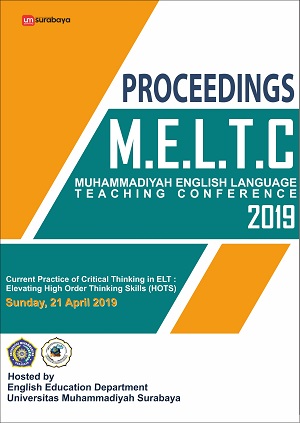Developing Problem-Based Speaking Assessment Of High Order Thinking Skills Implementation For Asd Students
Abstrak
In Indonesia, 2013 curriculum is the newest curriculum used after having some transformations. The implementation of 2013 curriculum is not an easy thing because the teacher has to understand well about it. High Order Thinking Skill (HOTS) implementation is mandated by the scientific-based 2013 national curriculum in Indonesia. It means that HOTS is one of the aspects in the 2013 curriculum that must be implemented. This must also be implemented to Autism Spectrum Disorder (ASD) students. ASD students are students with a lifelong biological disorder with a wide range of appearances. To implement HOTS, the ASD students had to be guided intensively by the teacher to think critically and creatively. However, most of the teachers got problems to develop the assessment that could stimulate ASD students’ critical thinking and creativity. This study aims to develop problem based speaking assessment of HOTS implementation to stimulate ASD students’ critical thinking and creativity. In this research, Research and Development approach was employed with the second grade ASD students of Yamastho primary school in the academic year of 2018/2019 as subject. The data collection instruments were a questionnaire, interview, observation checklist, and test. The researcher collaborated with the teacher to develop this assessment. The ASD students’ score speaking skill improvement was 60.33 to 75.33, critical thinking skill was 61.33 to 74.33 and creativity skill was 62.67 to 75.33. To know the significance of the research, the researcher used SPSS. The results indicated that there was a significant difference between the result of pre-test and post-test. In other words, there is a significant improvement in the ASD students’ speaking, critical thinking, and creativity skill after they used this assessment.
Keywords: ASD, HOTS, Problem-based Speaking Assessment, Critical Thinking, Creativity
Referensi
Abosalem, Y. (2016). Assessment techniques and students’ Higher-Order Thinking Skills. International Journal of Secondary Education, 4(1), 1-11.
American Psychiatric Association. (2000). Pervasive developmental disorders. In Diagnostic and statistical manual of mental disorders (4th ed.). Washington D. C.: American PsychiatricAssociation, 69-70.
Anazifa, R. D. & Djukri. (2017). Project-based learning and problem-based learning: are they effective to improve student’s thinking skills?. Jurnal Pendidikan IPA Indonesia, 6(2), 346-355.
Anugrahwati, Y. & Helena, I. R. A. (2015). The integration of second core competence (KI 2) of curriculum 2013 in english classes. Journal of English Language Teaching, 4(1), 1-8.
Aryulina, D. & Riyanto. (2016). A problembased learning model in biology education courses to develop inquiry teaching competency of preservice teachers. Cakrawala Pendidikan, (1), 47-57.
Boyd, B. A., & Shaw, E. (2010). Autism in the classroom: A group of students changing in population and presentation. Preventing School Failure, 54(4), 211-219. DOI: 10. 1080/1045988100374452
Dewi, C. L. (2017). Improving students’ creativity in writing recount text by using mind mapping. Jurnal Managemen Pendidikan, 12(2), 128-138.
Faridi, A. (2012). Language Teaching Theories. Semarang: Unnes Press.
Fulcher, G. (2003). Testing Second Language Speaking. New York: Pearson Education Limited.
Hayati, A., Alwen, B., & Ulfia, R. (2017). Analyzing the issues in the implementation of authentic assessment in the 2013 curriculum. Al-Ta’lim Journal, 24(1), 53-59.
Huang, K. & Tzu-pu, W. (2012). Applying problem-based learning (PBL) in university english translation classes. The Journal of International Management Studies, 7(1), 121-127.
Jaedun, A., Hariyanto, V.L., & Nuryadin, E.R. (2014). An evaluation of the implementation of Curriculum 013 at the building construction department of vocational high schoos in Yogyakarta. Journal of Education, 7 (1), 14-22.
Kasim, U., Teuku, Z., & Nasriati. (2017). Classroom practice: applying the scientific approach based on the 2013 curriculum. English Education Journal (EEJ), 8(4), 518-535.
Mainali, B.P. (2012). Higher order thinking in education. Academic Voices a Multidisciplinary Journal, 2(1), 5-10.
Sarigoz, O. 2012. Assessment of the high school students’ critical thinking skill. ProcediaSocial an Behavioral Sciences, 46. 5315- 5319.
Milchatun., Dwi, A. L. B., & Rudi, H. (2015). Improving students’ personal self concept through role play technique in teaching speaking skill. English Education Journal, 5(1), 1-9.
Mulyono, Y. (2018). Improving creativity of the future physics teachers through general biology learning based on CTL with experimental method. Indonesian Journal of Science and Education, 2(1), 62-68.
Rahman, M. A., et al. (2016). The impact of problem-based learning approach in enhancing critical thinking skills to teaching literature. International Journal of Applied Linguistics & English Literature, 5(6), 249-255.
Retnawati, H., Hadi, S., & Nugraha, A.C. (2016). Vocational high school teachers’ difficulties in implementing the assessment in curriculum 2013 in Yogyakarta province of indonesia. International Journal of Instruction, 9(1), 33- 48.
Prainsson, K. O. (2012). Second language acquisition and autism. (Master’s Thesis). Retrieved from: http://skemman.is/stream/get/1946/11473/28511/1/SLA_and_Autism_K.O._Thrainsson.pdf
Seel, N. M and Sanne, D. (2004). Curriculum, Plan, and Processes in Instructional Design. London: Lawrence Erlbaum
Associates. Umami, et al. (2018). The implementation of Hybrid Computer Mediated Collaborative Learning (HCMCL) for promoting students’ critical thinking at IAIN Salatiga, Indonesia. Arab World English Journal, (4), 160-173. White, John (Ed). (2004). Rethinking the School Curriculum: Values, aims and purposes. New York: Routledge Falmer.
Setiawan, A., & Bharati, D. A. L. (2018). Developing HOT Project-Based-Speaking Assessment to Stimulate the Students’ Critical Thinking and Creativity. English Education Journal, 8(3), 301-307.
Willis, C. (2012). Young children with autism spectrum disorder: Strategies that work. Teaching Young Children 5(4), 81-88.
Wire, V. (2005). Autistic spectrum disorder and learning foreign languages. Support for Learning, 20(3), 123-128.
Wu, M., et al. (2018). Creative thinking curriculum infusion for students of teachers’ education program. Jurnal Pendidikan Teknologi dan Kejuruan, 24(1), 1-12.






